The very short version, to paraphrase Ghostbusters: if someone asks if you’d like to go to Chernobyl, you say YES!
Fair warning, there are going to be units related to radiation dose discussed in this post. For an idea of what they mean and to put them in perspective, I recommend this excellent infographic by Randall Munroe from XKCD.
Last year, a photographer friend was directed my way for helpful radiation safety things to know when visiting the Chernobyl Exclusion Zone. Intending on just a few protips, I instead gave her many thousands of words of advice, but she didn’t end up going. This year, in mid-September, she dropped me a line again about going but, to paraphrase, “Rather than find and read all that stuff you sent me, and forget most of it, how about you come with me?” I told her that if she had things arranged already and was willing to just add my name to the permits, I’d be happy to go assuming flights weren’t too expensive. My flight from SFO to Kiev, with a few connections, round trip, ran $708. I have had flights that stayed in the US that were more expensive than that. Apparently, the demand to go to Kiev in early November is kinda low for some reason. Perhaps it’s the whole approaching winter thing or simmering conflict in near Donetsk scaring people away. Either way, I was happy and swooped on that deal for my Long Weekend in Chernobyl.
I’m gonna start with a thought that struck me on the long drive back to Kiev from the exclusion zone. About half way back, tired and wanting dinner, I thought “Fuck, we’ve been in the middle of nowhere forever.” Then I stopped and reconsidered, “Where we are right now is the middle of nowhere between Pripyat and Kiev. Pripyat used to be somewhere, the last stop before Belarus, rather than more nowhere.” Of all the villages, towns and cities evacuated when the 30km Chernobyl Exclusion Zone was established, the most prominent one to empty and stay empty was Pripyat. Pripyat was a GLORIOUS NEW CITY OF SOVIET FUTURE!!! and you can see it in the propaganda-as-architecture everywhere you look.
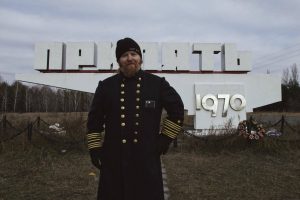
Pripyat was a planned town, built out of whole cloth in 1970. When you look around there is no organic feel to the growth of the city, other than the trees and weeds that have conquered it in the 30 years since. Perhaps this look of unitary construction to an entire city is more common in the rebuilt environment of postwar-Europe or a Chinese “Instant Metropolis, Just Add Water”, but the only place I can really remember encountering this feeling in America is Disneyland. Disneyland creeps me out badly for reasons that are hard to explain, but this felt right. Maybe it’s a matter of purpose to the construction and Disney’s purpose rubs me deeply the wrong way. Pripyat, on the other hand, was intended to be a showcase of what the peaceful use of atomic energy could do. In fact, on top of one of the buildings, across the entire length, there used to be a giant lit up sign that said something like “Let Atom Be A Worker, Not A Soldier” which sure sounds like something from the Children of Atom in Fallout. And because the authorities felt pretty confident in the safety of the RBMK reactor design, it’s the first of the Soviet atomic cities that wasn’t closed, and didn’t require papers to come and go (Russia still has some closed cities and technically America still has one).
In short, Pripyat was a place for up and comers. The reactor staff of thousands was well educated, perhaps not the cream of the Academy but some of the best scientific and technical minds around. The military associated around here were people working on new and interesting projects, one of which I’ll get to in a future post, and were just generally not the Red Army’s grunts. But what the city was above all else was young. I’m informed that the average age of the population of Pripyat when the accident happened was ~25, which means if you’ve wandered around the usual watering holes of recent college grads and postdocs you probably have a feel for what Pripyat was like. And if you want those young up and comers to be happy, stay, and want to do their best for you, you’re gonna have to give them incentives, luxuries, such that the Soviet Union could provide.
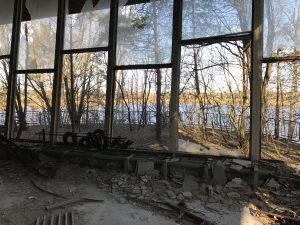
The American vision of life in the latter days of the Soviet Union is dark, grim, and filled with lines to buy nothing from empty stores. Perhaps that was life in Moscow, but that’s not the impression I got of the the last days of Pripyat just looking around. In a setting that wouldn’t look out of place on the promenade and marina of any prosperous city, there was a cafe on the Pripyat River where you had the choice of sitting on the patio and watching the boats go by or you could go sit in the beautiful, though mostly destroyed now, stained glass window seating area.
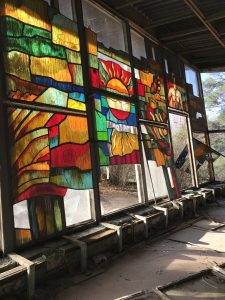
Or perhaps you’d like to go to the cinema? Or the music school/symphony? Don’t worry, Pripyat has you covered there with it’s own independent ones from the central Palace of Culture. And, oh my god, the Palace of Culture was a sight to behold. The more I walked through that place and realized how much had been in that building, how much was going on, the more and more angry I got that America doesn’t have anything that even comes close to what the Pripyat’s Palace of Culture was once like. The closest equivalent is like a grange or community hall, but that’s kinda like comparing the crappy rides in front of a supermarket to Six Flags. The Palace of Culture had multiple large theaters, libraries, a possible wine bar and cafe, shooting ranges, a gymnasium, lecture halls, an electronics workshop, dance studios, etc. And Pripyat wasn’t even a particularly large city.
But, well, we know how this story ends. Glorious City of the Soviet Future is abandoned 48hrs after the fire at Chernobyl-4 begins. Children are allowed to bring one toy with them, most of which are confiscated due to contamination, and are told they’ll be allowed to come back in a couple weeks. Instead, the poor residents of Pripyat got an entirely new town, 50km due east of the power plant. You see, they were mostly power plant workers and we still needed the power from the other three operating reactors, which didn’t actually shut down until 2001, and a place to house all the people working on the emergency response. Today, without a particular reason to exist 15 years after shutting down Chernobyl-1 through 3, Pripyat’s replacement is heading towards becoming a ghost town too.
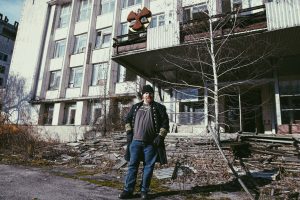
During the Battle of Chernobyl, as Gorbachev termed it to get the Soviet people motivated like it was the Battle of Stalingrad, Pripyat was the staging ground for the work to put out the fire and build the eventual Sarcophagus that would contain the destroyed reactor. The old city hall, for lack of a better term, got turned into an ersatz atomic emergency incident command center. Unfortunately, at the time of the accident, the Soviet Union didn’t quite have a civilian agency like America’s Nuclear Regulatory Commission, or even the old Atomic Energy Commission, so they were kind of making it up as they went along with Valery Legasov tagged by Gorbachev to lead the way. In light of that, their success in a failure is not an option situation is to be commended. At an admittedly high human price among the Liquidators, but still a successful emergency response.
Beyond the fight to get control of the reactor, there was a totally separate effort to control the spreading contamination from fallout. As I helped explain with Maki Naro in his “Fallout Guy” comic series earlier this year, fallout rains out in a predictable manner based on wind speed and direction, temperature (the fire unfortunately lofted things high), and particle size. Pripyat was downwind from the accident and took the brunt of it, though the Red Forest (so named because of the color all the pine trees turned when they died) between the reactor and the city got the worst. They made a commitment that they’d clean up all the contamination in Pripyat and save what they could. The first step in contamination control was to stop it blowing around and washing off as much as possible by trying to fix it into place. Think of the fire tanker planes. Now think of them dousing the city and countryside with something like glue instead. All the contamination was all still there, but at least they weren’t going to be surprised by it moving every day and made it easier to map so you could go back and scrape, power wash, or whatever to clean it off later. And honestly, as someone who used to do a lot of decon for a living, they did a great job. The general dose rates around town are only a couple times background. Inside buildings, as long as you stay away from the broken windows where stuff has since blown or dripped in, dose rates are pretty much background. After all, fallout lands on the building, not in the building. Any contamination you find inside is something that has either been tracked, say by looters or early tourists who didn’t do a great job with contamination control (such as the Pripyat hospital), or more likely water infiltration.
This isn’t to say that I found no elevated dose rates in Pripyat. Goodness me, no. Because I can’t turn off that part of my brain for very long, as we were wandering through the city I started looking around and trying to figure out:
- Where would low level contamination that was “clean enough” and left behind have concentrated over 30 years?
- Where would the Liquidators have missed something and left a hot spot behind?
Thanks to the nice folks at Thermo Scientific, I’d brought my personal RadEye B-20 to go surveying with. For the first question, at the riverfront cafe, I reasoned that this was a low lying area and that rain run off would have generally run toward the waterfront. So slowly started at where the downspouts once were (identified them by the rusty brackets from where they’d been stolen from) and traced my way along the path down to the quay. Sure enough, at the seam in the concrete where the slope down from the cafe hit the flat of the quay, the dose rates jumped up from 30μSv/hr just walking around the area to 10mSv/hr from everything that had gotten caught in that crack.
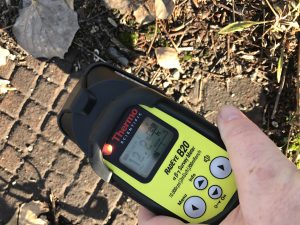
Perhaps the most iconic part of the Pripyat that everyone knows from pictures is the rusted Ferris wheel from amusement park. Like a lot of things in the Exclusion Zone, the amusement park has the sad quality of having just been built but never used when the accident happened. It was intended to open for the May Day celebration in a mere six days when Chernobyl-4 went up. While my compatriot was off trying to get excellent shots of the bumper cars, I started wandering around toward the trees on the edges of the amusement park looking for elevated dose rates. My reasoning of basic human laziness was that you clean the easy open ground of asphalt in the park, but probably get a little slack near the edges. Before I even got there, my meter alarmed, making the nearby ravens rather upset. I was standing next to a manhole cover and had a dose rate of .12mSv/hr roughly foot above it.
So, I stepped away from that and walked toward another bit of woods nearer to the Ferris wheel. Meter alarm went off again as I approached a pile of litter I soon figured out was an open manhole. I stuck my hand and meter down there and hit 1.5Sv/hr, which officially exceeded the amount of fun I was willing to have with recreational dose rather than occupational. PROTIP: don’t play in the sewers of Pripyat. I then walked from the open manhole back to the covered one, meter clicking away quite happily all the way, and realized I was tracing the storm drain line with my meter. You see, the Liquidators cleaned a lot of surfaces and the results of their efforts are frankly remarkable, but they also committed the failure of every rad decon and demolition project I’ve ever worked on: not going below grade (i.e. contamination in pipes underground, like sewer lines). That’s expensive and hard work, so they left it. Considering that there was still a reactor that needed buttoning up a few miles away, I can understand choosing your battles.
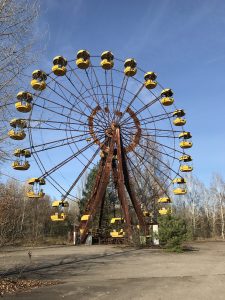
The main thing I took away from Pripyat is that I want to go back. The urban explorer desire screams at me that I barely scratched the surface of all the buildings there. At the very least, I want to get into the “Politburo hotel”. I want to know what the interiors of hotel built with visiting senior Communist party officials in mind looks like. And I want a damn clear shot of the Cyrillic sign for “LET ATOM BE A WORKER, NOT A SOLDIER”, I never found a good line of sight for it. I also want to know who is living in that ghost city because right after leaving the amusement park I met the most friendly cat who was well fed and happy. Feral cats don’t come near you, so that was clearly someone’s pet.
And since you made it this far, I’ll end this with a the traditional picture of the Ferris wheel and remind you that there’s only 9 days left to order in the current BBotE & Stein production window. After that, if you’re hoping to get something in time for Xmas, there’s no guarantees I can get things out to you in time.
NEXT TIME: Let’s talk reactors, sarcophagi, New Safe Confinement, and what the hell is that thing over there?